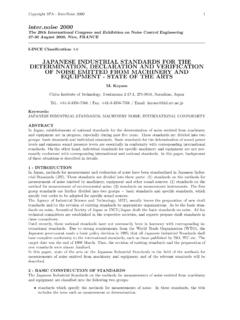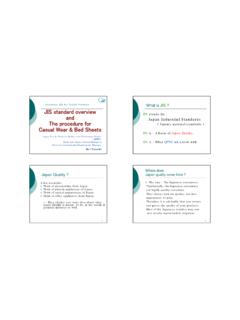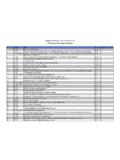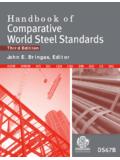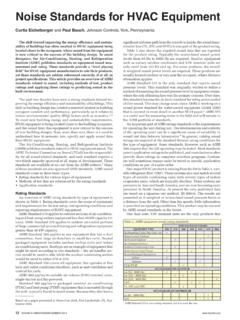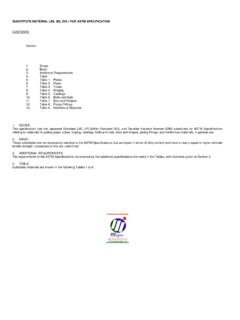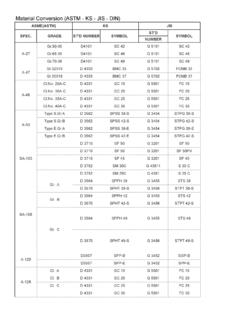Transcription of HOISTS AND CRANES - harringtonhoists.com
1 HOISTS AND CRANES Hoist Classifications Lifting Motor Duty Ratings GENERAL USE EDOC0636 Page 1 of 10 06/23/11 Introduction and Terminology Purpose Section 1 provides introductory information to help the reader of this EDOC better understand the meaning and purpose of Lifting Motor Duty Ratings and Hoist Classifications. Also, some terminology and organization names are defined. Background Harrington offers many different hoist types to many different end users. All HOISTS have certain capabilities and certain limitations while all end users have different requirements and applications in mind. Because of the variety of product and end user, it is necessary to have systems in place to make sure each hoist is suitable for the application for which it is intended. Scope Hoist Classifications and Duty Ratings apply to any hoist.
2 Lifting Motor Ratings apply to the motor within an electric hoist. Glossary of Terms (alphabetically) ASME- (American Society of Mechanical Engineers)- A professional engineering society founded in 1880 that is widely known for establishing codes and standards for mechanical devices. Cubic Mean Value (k)- Percentage of (working load limit). Ex: k= means 63% of Duty Rating- The classification given to a hoist indicating the amount of use and type of use it can withstand during a given time period. FEM- (European Federation of Materials Handling)- An association founded in 1953 that represents manufacturers of materials handling, lifting and storage equipment. FEM is involved with establishing technical recommendations and guidelines. Hoist Classification- The categorization of HOISTS is according to state of loading, duration of use and area of application.
3 ISO- (International Organization for Standardization)- An international organization founded in 1947 that issues worldwide industrial and commercial standards . JIS- (Japanese Industrial standards )- standards used for industrial activities in Japan published through JSA- Japanese standards Association. Lifting Motor- Rotating machine that transforms electrical energy into mechanical energy. Lifting Motor Rating- A rating of an electric motor s capability indicated by how long a certain cycle of use can be maintained, a ratio of motor on-to-off time (% ED) and a maximum number of starts per hour. Mean Effective Load- A theoretical single load value that will have the same effect on the hoist mechanism as various, randomly distributed loads that are applied to the hoist in some specified period of time. Mean Effective Load Factor (K)- A ratio of the Mean Effective Load to the hoist rated capacity.
4 State of Loading- An indication of the frequency and magnitude of loads a hoist can handle. (Working Load Limit)- The maximum load which should be applied to the hoist. HOISTS AND CRANES Hoist Classifications Lifting Motor Duty Ratings GENERAL USE EDOC0636 Page 2 of 10 06/23/11 Lifting Motor Duty Ratings Purpose Section 2 discusses Lifting Motor Duty Ratings. Section discusses Short Time Rating and section discusses Intermittent Rating (% ED) / Maximum Number of Starts per Hour. Short Time Rating Short Time Rating is a rating of how many minutes a hoist can be operated continuously at the This rating relates to the rise in motor temperature that occurs during operation. In order to be given a Short Time Rating of 60 min., a hoist must endure 60 min. of the cycle depicted in Figure 1 at its without exceeding its allowable maximum temperature and without showing signs of damage.
5 This cycle consists of a lift of 1 meter, a 3 second stop, a lowering of 1 meter and another 3 second stop before the cycle is repeated. Figure 1. Short Time Rating Cycle Any Single Speed ER Series Harrington Hoist, single phase or 3-phase, could endure this cycle for 60 consecutive minutes, earning its 60 min. Short Time Lifting Motor Rating. A Dual Speed ER Harrington Hoist could endure this cycle for 30 consecutive minutes on its high speed and for 10 consecutive minutes on its low speed, earning it its 30/10 min. Short Time Lifting Motor Rating. The higher of the two speeds can endure longer operation because when the motor speed is higher, the cooling fan speed will also be higher. Therefore, the hoist cools itself more effectively at a higher speed. HOISTS AND CRANES Hoist Classifications Lifting Motor Duty Ratings GENERAL USE EDOC0636 Page 3 of 10 06/23/11 Intermittent Duty Rating (% ED) / Max.
6 Number of Starts Intermittent Duty Rating (% ED) indicates how much time a hoist can be operating within a given period of time - (a maximum of 10 minutes). This rating also relates to the rise in motor temperature that occurs during operation. The cycle in Figure 2 is specified for a hoist being operated at 63% of the For a Single Speed Hoist Figure 2. Intermittent Rating (% ED) Cycle For A Single Speed Hoist The cycle consists of a lift of duration t1, a stop of duration t2, a lowering period of duration t3 and another stop of duration t4 before the cycle is repeated. T represents the total time to complete the cycle where the total time is no greater than 10 minutes. % ED Is Calculated By: % ED =[(t1 + t3) / T] x100 =[(motor ON time) / (total cycle time)] x100 % ED and Max Starts Per Hour: FEM designates the maximum starts for 60%ED to be 360 starts per hour.
7 If the allowable number of starts per hour is exceeded, a hoist could be operated within 60%ED and still experience excessive temperature rise. This could occur because when a motor starts from a complete stop, it experiences a spike in current that exceeds the rated motor current. This current spike generates extra heat and could cause defects or motor burning if 360 starts per hour is exceeded. What This Means: If a single hoist is operated under the limitations of its designated rating and starts per hour, the rise in motor temperature will not exceed the maximum allowable motor temperature. If the hoist is operated in this manner, the hoist can be operated continuously in consecutive hours. HOISTS AND CRANES Hoist Classifications Lifting Motor Duty Ratings GENERAL USE EDOC0636 Page 4 of 10 06/23/11 For a Dual Speed Hoist Figure 3.
8 Intermittent Rating (% ED) Cycle For A Dual Speed Hoist This cycle consists of a low speed lift (t1), a high speed lift (t2), a low speed lift (t3), a stop (t4), a low speed lowering (t5), a high speed lowering (t6), a low speed lowering (t7) and a stop (t8). T represents the total time to complete the cycle where the total time is no greater than 10 minutes. % ED Is Calculated By: % ED (Low Speed) = [(t1 + t3 + t5 + t7) / T] x100 = [(motor ON time at low speed) / (total cycle time)] x100 % ED (High Speed) = [(t2 + t6) / T] x100 = [(motor ON time at high speed) / (total cycle time)] x100 % ED (Total = Low Speed + High Speed) =[(t1 + t2 + t3 + t5 + t6 + t7) / T] x100 =[(motor ON time total) / (total cycle time)] x100 As the third formula above shows, total %ED for a dual speed hoist is the sum of the Low speed and High speed %ED.
9 In the case of a Dual speed ER hoist, the %ED is 40(High speed)/20(Low speed). Therefore, its total %ED would be (40%ED + 20%ED) = 60%ED. % ED and Max Starts Per Hour: As mentioned earlier, FEM designates the maximum starts for 60%ED to be 360 starts per hour. As seen in Figure 3, the cycle alternates between low and high speed, beginning and ending with low speed. Therefore, the cycle consists of 4 low speed motor starts and 2 high speed motor starts, making the ratio of low speed to high speed starts 2:1. In accordance with this ratio, the allowable starts per hour is divided into 240 allowed at low speed and 120 allowed at high speed, maintaining a total of 360 starts per hour. What This Means: If a dual hoist is operated under the limitations of its designated rating and starts per hour, the rise in temperature will not exceed the maximum allowable motor temperature.
10 If the hoist is operated in this manner, the hoist can be operated continuously in consecutive hours. HOISTS AND CRANES Hoist Classifications Lifting Motor Duty Ratings GENERAL USE EDOC0636 Page 5 of 10 06/23/11 Hoist Classifications Purpose Section 3 discusses Hoist Classifications. Section discusses ASME HST classification, section discusses ISO/JIS classification and section discusses the relation between FEM and ISO classifications. ASME HST Figure 4 shows the various hoist duty classifications as determined by ASME HST. Figure 4. Hoist Classifications determined by ASME HST. As Indicated by Figure 4: Three Hoist Duty Classes (H2, H3, and H4) are indicated next to their corresponding typical area of application. Each typical area of application is designated according to volume of handling and how frequently the rated load would be lifted.








